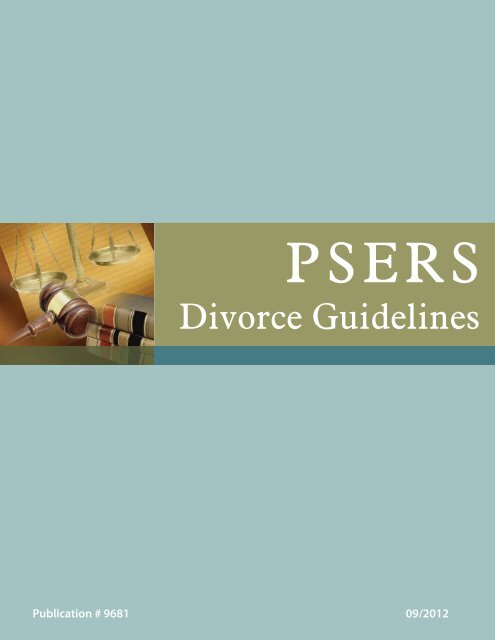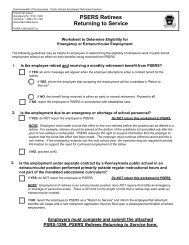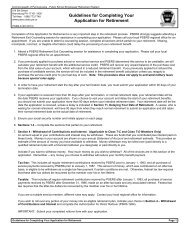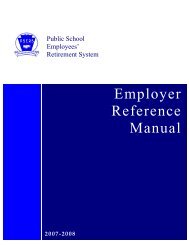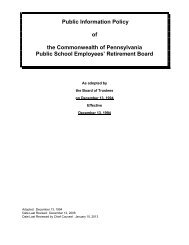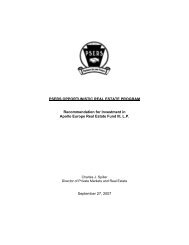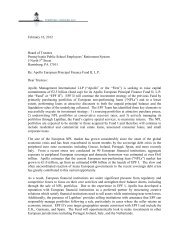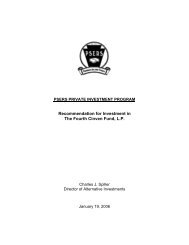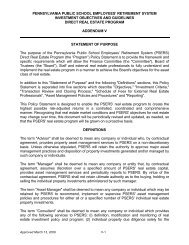Divorce Guidelines.indd - PSERs
Divorce Guidelines.indd - PSERs
Divorce Guidelines.indd - PSERs
You also want an ePaper? Increase the reach of your titles
YUMPU automatically turns print PDFs into web optimized ePapers that Google loves.
PSERS<br />
<strong>Divorce</strong> <strong>Guidelines</strong><br />
Publication # 9681 09/2012
PSERS <strong>Divorce</strong> <strong>Guidelines</strong><br />
Revised September 11, 2012<br />
Public School Employees' Retirement System - Who are we? .................................. 1<br />
How is a PSERS retirement benefit affected by a divorce? ....................................... 1<br />
What portion of the PSERS' account is Marital Property? ......................................... 1<br />
How is the value of a Member’s account obtained? ................................................... 2<br />
How is PSERS informed of the results of Equitable Distribution of the Member’s<br />
account with PSERS? ................................................................................................... 3<br />
Are there any rules regarding a DRO? ......................................................................... 3<br />
How does a DRO become an ADRO? .......................................................................... 5<br />
Do you have any examples of an ADRO? .................................................................... 5<br />
Can a Member file an Application for Retirement before the divorce is finalized? .. 9<br />
When are the benefits paid under an ADRO? ........................................................... 10<br />
What is an Interim Domestic Relations Order (IDRO)? ............................................. 11<br />
How will taxes on the benefit be handled? ................................................................ 11<br />
What happens if the Alternate Payee or the Member dies before a <strong>Divorce</strong> Decree<br />
is entered? ................................................................................................................... 11<br />
Are there circumstances other than death in which an Alternate Payee’s share of<br />
the Member's retirement benefit would stop? ........................................................... 12<br />
Glossary of Terms ....................................................................................................... 12<br />
NOTE: The information contained in this document is not intended as legal advice<br />
and is not to be used in place of legal counsel. The information is intended to<br />
provide general information to PSERS’ Members regarding their retirement<br />
benefits and divorce actions. PSERS strongly recommends that Members<br />
involved in a divorce contact a family law attorney.
Public School Employees' Retirement System - Who are we?<br />
The Public School Employees' Retirement System (PSERS) is an agency of the<br />
Commonwealth of Pennsylvania that manages a governmental pension plan for<br />
Pennsylvania public school employees. PSERS is defined under the Internal Revenue<br />
Code (IRC) as a 401(a), Defined Benefit Plan.<br />
Because of PSERS’ status as a governmental pension plan, PSERS is exempt from<br />
pension plan requirements outlined in the Employee Retirement Income Security Act<br />
(ERISA), the Retirement Equity Act of 1984, and the IRC regarding a Qualified<br />
Domestic Relations Order (QDRO) and Spousal Consent. This means that in the<br />
absence of a divorce action, a Member may take any action with regard to his or her<br />
retirement benefit without notice or consent from anyone, including the Member’s<br />
spouse.<br />
How is a PSERS retirement benefit affected by a divorce?<br />
As the retirement benefit may be one of the largest financial assets a Member may<br />
have, the division of the benefit may become an important issue in a divorce agreement.<br />
The retirement benefits payable to a Member of PSERS are sometimes classified as<br />
Marital Property that can be divided in a divorce. The division of Marital Property in a<br />
divorce is known as Equitable Distribution.<br />
Any attachment of a Member’s retirement benefit for the purpose of Equitable<br />
Distribution must be accomplished through the terms of an Approved Domestic<br />
Relations Order (ADRO) as set forth in the Public School Employees’ Retirement<br />
Code (Retirement Code), 24 Pa.C.S. § 8101 et seq.<br />
Note: Although a Property Settlement Agreement (PSA) may be incorporated<br />
into the <strong>Divorce</strong> Decree and may form part of the language used in the ADRO,<br />
the PSA, in itself, is not sufficient to constitute an ADRO.<br />
What portion of the PSERS' account is Marital Property?<br />
Pennsylvania law identifies the Marital Property Component in terms of a Coverture<br />
Fraction, which is defined by law as follows: The denominator is the number of months<br />
the Member worked to earn the total benefit and the numerator is the number of such<br />
months during which the parties were married and not finally separated. 23 Pa.C.S.<br />
§3501(c).<br />
Note: The <strong>Divorce</strong> Code defines the Coverture Fraction in terms of months.<br />
The Retirement Code, however, defines the benefit based on eligibility points<br />
earned over a period of time. Accordingly, PSERS calculates the benefit, for<br />
purposes of the Coverture Fraction, based on the percentage of service credit<br />
earned during the months of marriage, divided by the service credit earned<br />
during the entire period of employment. See example in the definition of<br />
Coverture Fraction.<br />
1
PSERS, however, will allow the ADRO to define the Marital Property Component<br />
using a different numerator and denominator or a pre-defined amount. See the section<br />
entitled, “Do you have any examples of an ADRO?” for further information.<br />
The benefit to which the Coverture Fraction is applied will include any lump sum<br />
withdrawals and/or scheduled or ad hoc increases, but will exclude, unless otherwise<br />
stated in the ADRO, the disability supplement of any disability annuity paid to the<br />
Member by PSERS and any enhancements to the Member’s retirement benefit arising<br />
from post-separation monetary contributions made by the Member. 23 Pa.C.S.<br />
§ 3501(a.1).<br />
If the Member is a Multiple Service Member, the Member’s credited state service with<br />
the State Employees’ Retirement System (SERS) will be included in the value of the<br />
Member’s account and the calculation of the Coverture Fraction unless otherwise<br />
stated in the Domestic Relations Order (“DRO”).<br />
PSERS’ role in interpreting DROs is to determine compliance with the Retirement Code<br />
and not whether the terms are beneficial to either party or are in compliance with other<br />
agreements (e.g. PSA) established between the parties.<br />
Note: A separate interest approach is not authorized under the Retirement<br />
Code. The Retirement Code provides, in pertinent part, that PSERS shall<br />
approve a DRO only if: (i) the benefit provided is of the same type or form<br />
already provided by the Retirement Code; (ii) the DRO specifies the retirement<br />
option to be elected by the Member upon retirement (or states the Member can<br />
elect any option provided under the Retirement Code); and (iii) the DRO does<br />
not grant an Alternate Payee any of the rights, options or privileges of a<br />
Member under the Retirement Code. 24 Pa.C.S § 8533.1(a).<br />
How is the value of a Member’s account obtained?<br />
PSERS can provide the valuation of the Marital Property Component of the Member’s<br />
account. The valuation is different from a retirement estimate. The value of the Marital<br />
Property Component is based on the value of the Member’s account as of the date the<br />
valuation is calculated, not as of the estimated date of retirement.<br />
Note: Any valuation of a Member’s account is an estimate and does not<br />
guarantee that the benefit stated on the valuation will actually be the benefit at<br />
the time of retirement.<br />
To request a valuation of the Member’s account, PSERS must receive a written request.<br />
The written request must include the date of marriage and the date of legal separation.<br />
The valuation should be requested at least four weeks in advance of when the<br />
information is needed. If the request cannot be submitted at least four weeks in<br />
advance, please provide the date the information is needed and PSERS will try to<br />
accommodate the request, if possible.<br />
Note: If the Member is a Multiple Service Member, the valuation of the<br />
Member’s account with SERS will not be included. A separate valuation should<br />
be obtained from SERS.<br />
2
If someone other than the Member is requesting a valuation, an authorization for release<br />
of information signed by the Member must be submitted with the request.<br />
How is PSERS informed of the results of Equitable Distribution<br />
of the Member’s account with PSERS?<br />
PSERS requires the submission of a DRO for review and approval. The proposed DRO<br />
should be submitted to PSERS for review and approval prior to obtaining the court<br />
signature.<br />
To submit the DRO for review, mail it to:<br />
Specialized Service Section<br />
PSERS<br />
5 North 5th Street<br />
Harrisburg PA<br />
17101-1905<br />
In the event that there is no Equitable Distribution of the PSERS account, the former<br />
spouse must submit a Waiver of Pension Benefits (PSRS-1286) form to PSERS. This<br />
waiver form is available by calling PSERS or by accessing PSERS’ website,<br />
www.psers.state.pa.us.<br />
Are there any rules regarding a DRO?<br />
1. In no case can the DRO alter the PSERS’ benefit structure. The benefit structure is<br />
limited to the retirement options established by the General Assembly under the<br />
Retirement Code. 24 Pa.C.S. §§ 8341-8349. The DRO cannot require PSERS to<br />
pay benefits other than those described in the Retirement Code. The total benefits<br />
payable to the Member and the Alternate Payee, therefore, cannot exceed the<br />
benefit which would have been payable in the absence of a divorce. Any substantive<br />
changes to the benefit structure are outside the jurisdiction of the Courts of Common<br />
Pleas. Millick v. Millick, 592 A.2d 788 (Pa.Cmwlth. 1991). Additionally, the DRO<br />
cannot allow the Alternate Payee to exercise any of the rights, options or privileges<br />
of a Member. See the section entitled, “Do you have any examples of an ADRO?”<br />
for further information on the benefit structure available.<br />
2. The Alternate Payee may not receive disbursements (of a monthly annuity or lump<br />
sum) before the Member terminates service and submits either (1) an Application for<br />
Retirement (PSRS-8), (2) an Application for Disability Retirement (PSRS-49) or (3)<br />
an Application for Refund (PSRS-59).<br />
Note: To have a retirement date effective the first day after termination of service<br />
or the day a Vestee reaches superannuation retirement age, PSERS must<br />
receive the Member’s Application for Retirement (PSRS-8) within 90 days of the<br />
Member’s termination date or attainment of superannuation retirement age for<br />
Vestees. See the sections entitled, “When are the benefits paid under an<br />
ADRO?” and “Can a Member retire before the divorce is finalized?” for further<br />
information.<br />
3
3. If the Member chooses an option other than the Maximum Single Life Annuity<br />
(MSLA), the monthly annuity is reduced by the cost of the option. The DRO must<br />
state whether the Alternate Payee is required to share the cost of the retirement<br />
option.<br />
Note: If not mentioned, PSERS will not accept the DRO. See the section<br />
entitled, “Do you have any examples of an ADRO?” for more information.<br />
4. Although the parties can provide for an interim distribution or assignment of Marital<br />
Property prior to the issuance of a <strong>Divorce</strong> Decree, there is no such thing as an<br />
“interim retirement application.” Once a Member files an application, the option<br />
elected on the Member’s portion can be changed only: (1) under the option change<br />
regulation or (2) if the Member had chosen a joint and survivor annuity and the<br />
Member later divorces or marries.<br />
Note: If the Member chooses a MSLA or Option 1 on the Alternate Payee’s<br />
portion under an Interim Domestic Relations Order (IDRO), an amended DRO<br />
cannot override the Retirement Code to allow the Member to change this option<br />
election. In this case, the amended DRO can only divide the existing payments<br />
(or Member can name the Alternate Payee as Beneficiary for all or part of the<br />
death benefit, if any). To preserve the right to change the option on the<br />
Alternate Payee’s portion, the Member must elect a joint and survivor annuity<br />
option prior to the issuance of a <strong>Divorce</strong> Decree (or re-marriage). See the<br />
section entitled, “Do you have any examples of an ADRO?” for more information<br />
on options.<br />
5. A DRO is not required for support orders or orders for enforcement of arrearages<br />
under the <strong>Divorce</strong> Code. These orders will be approved separately provided they<br />
do not exceed the Pennsylvania or federal law limits on attachment.<br />
6. If a divorce court amends an ADRO for any reason, the amended order must be<br />
submitted to PSERS for approval as an ADRO.<br />
7. If the Member retires under a disability, the Member’s disability supplement is<br />
excluded from the calculation of the Martial Property Component unless the DRO<br />
specifically states it is to be included.<br />
Note: Option elections are limited for disability annuitants, e.g., cannot withdraw<br />
Accumulated Deductions. Payments made under a disability MSLA provide a<br />
death benefit that depletes over the life of the annuity.<br />
8. An Alternate Payee may elect to have any portion of an eligible rollover distribution<br />
paid directly to an eligible retirement plan by way of a Direct Rollover.<br />
Note: The IRS requires that PSERS withhold 20% federal withholding tax from<br />
the taxable portion not rolled over to an eligible retirement plan.<br />
9. The DRO should state whether the Member is required to name a specific<br />
Beneficiary and/or Survivor Annuitant for all or part of the benefit.<br />
Note: If not mentioned, PSERS will allow the Member to name any Beneficiary<br />
or Survivor Annuitant for the entire benefit.<br />
4
How does a DRO become an ADRO?<br />
A DRO is not effective unless it is approved by PSERS. Upon PSERS’ acceptance of<br />
the proposed DRO, signatures of both parties and the court, or, at a minimum, the court,<br />
are required.<br />
Once PSERS receives the court-signed ADRO, a final approval letter will be provided. If<br />
either party does not agree with the PSERS’ interpretation of the ADRO, they must<br />
contact PSERS immediately. If they do not, PSERS will administer the ADRO as stated<br />
in the approval letter.<br />
Do you have any examples of an ADRO?<br />
The following guidelines correspond with the numbered paragraphs on the<br />
sample ADRO attached as Appendix A. This is NOT an exhaustive list of what<br />
should/could appear in the DRO; however, failure to include the below<br />
information may result in the DRO being rejected by PSERS.<br />
1. Plan Information – The name of the plan to which the Order applies and a statutory<br />
reference to the Retirement Code.<br />
2. Member Information – Name, date of birth, social security number, and mailing<br />
address.<br />
3. Alternate Payee Information – Name, date of birth, social security number, and<br />
mailing address.<br />
4. Address Notification – A statement indicating that it is the responsibility of the<br />
Member and Alternate Payee to maintain current address information on file with<br />
PSERS.<br />
5. Definition of Retirement Benefits – A statement defining the Member’s retirement<br />
benefit as all monies payable to or on behalf of Member by PSERS. The DRO must<br />
state whether the following is included or excluded: lump sum withdrawals,<br />
scheduled or ad hoc increases, the disability supplement of any disability annuity<br />
paid to Member by PSERS, and enhancements to the Member’s retirement benefit<br />
arising from post-separation monetary contributions made by Member. If the<br />
Member is a Multiple Service Member, then the Present Value of the Member’s<br />
credited state service with the SERS will be included unless otherwise stated in the<br />
DRO.<br />
Note: Deferred Compensation is not part of the PSERS benefit; therefore, if the<br />
DRO states that Deferred Compensation is to be included, the DRO will be<br />
rejected by PSERS.<br />
6. Defining the Alternate Payee’s Equitable Distribution – The paragraph must<br />
clearly set forth the Marital Property Component of the Member’s retirement<br />
benefit by describing the method by which to calculate, or the pre-defined amount of,<br />
the Alternate Payee’s Equitable Distribution portion of the Member’s retirement<br />
benefit, i.e. Alternate Payee’s portion. Because the PSERS retirement benefit is<br />
comprised of both Accumulated Deductions and monthly annuity, the DRO must<br />
5
state what portion of the Member’s benefit (lump sum, monthly annuity, or both) the<br />
Alternate Payee is to receive.<br />
Note: If the Alternate Payee is not entitled to a portion of the Member’s<br />
lump sum withdrawal, or the lump sum is to be determined in a different<br />
way (other than the method used to calculate the monthly annuity), this<br />
must be specified in the DRO; otherwise, the lump sum distribution to<br />
the Alternate Payee will be calculated by applying the same method<br />
used for the monthly annuity. The monthly annuity is actuarially reduced<br />
by the lump sum withdrawn.<br />
There are two recommended methods:<br />
‣ Marital Property Component – If the Alternate Payee’s portion is to be<br />
determined using a Marital Property Component methodology, observe the<br />
following:<br />
a) The components to be used in determining the Marital Property<br />
The date of retirement, final average salary, service, and Accumulated<br />
Deductions determine the Member’s retirement benefit, and<br />
subsequently, the Alternate Payee’s portion. The parties must specify<br />
the dates to be used to calculate the Marital Property [e.g. actual<br />
retirement date or date of separation].<br />
Note: If the parties choose to limit the final average salary, service,<br />
and/or Accumulated Deductions to a different date [e.g. date of<br />
separation], this must also be stated in the DRO.<br />
b) The Coverture Fraction<br />
A Coverture Fraction can be used to isolate the Marital Property. The<br />
Coverture Fraction is a fraction with a value less than or equal to one.<br />
Although the <strong>Divorce</strong> Code defines the Coverture Fraction in terms of<br />
months, the Retirement Code defines the benefit based on eligibility<br />
points earned over a period of time because public school employees do<br />
not always work 12 months to receive a full year of service credit.<br />
Accordingly, PSERS calculates the benefit, for purposes of the Coverture<br />
Fraction, based on the percentage of service credit earned during the<br />
months of marriage, divided by the service credit earned during the entire<br />
period of employment. PSERS will allow the DRO to utilize a different<br />
numerator and denominator if the parties are in agreement. If the<br />
Member is a Multiple Service Member, then the Member’s credited<br />
state service with the SERS will be included in the Coverture Fraction<br />
unless otherwise stated in the DRO.<br />
Note: Include the actual dates (month, day, year) of the measuring<br />
period.<br />
c) The Alternate Payee’s share of the Marital Property Component<br />
This figure should be expressed in a percentage.<br />
- OR -<br />
‣ Pre-defined amount – If the Alternate Payee’s portion is a sum certain,<br />
observe the following:<br />
a) The DRO must specify whether the amount is to be paid as a lump sum,<br />
monthly annuity, or both.<br />
6
) If the Alternate Payee’s portion is to be paid as a lump sum (from the<br />
Member’s lump sum withdrawal), this amount cannot be more than the<br />
Member’s Accumulated Deductions.<br />
Note: If the Member retires under a disability retirement, the Member is<br />
prohibited from withdrawing any Accumulated Deductions.<br />
c) If the Alternate Payee’s portion is to be paid over a period of time from<br />
the Member’s monthly annuity, the DRO must specify the amount or<br />
percentage that the Alternate Payee will receive each month.<br />
Note: The retirement option elected by the Member must be sufficient to<br />
protect the Alternate Payee’s specific monthly amount.<br />
7. Death of Member (naming Alternate Payee as Irrevocable Beneficiary) – A<br />
statement indicating that the Member is nominating the Alternate Payee as an<br />
Irrevocable Beneficiary for all or part of the death benefit paid by PSERS.<br />
If the DRO requires the Alternate Payee to be named as Irrevocable Beneficiary,<br />
then, regardless of whether the Member is required to elect a specific option on the<br />
Alternate Payee’s portion at the time of retirement, the Alternate Payee’s portion of<br />
any pre-retirement death benefit will be calculated based on an Option 1 death<br />
benefit, unless stated otherwise in the DRO. See 24 Pa.C.S. § 8347.<br />
Note: If the Alternate Payee is entitled to a portion of the Member’s preretirement<br />
death benefit and the Alternate Payee’s portion of the Member’s<br />
retirement benefit is to be a specific amount or percentage, the DRO must specify<br />
the Alternate Payee’s portion of the death benefit as a specific amount or<br />
percentage of the Member’s death benefit.<br />
8. Authorization for Release of Information – A statement indicating that the Member is<br />
authorizing PSERS to release information to the Alternate Payee.<br />
Note: If not specifically authorized, PSERS will not release information to the<br />
Alternate Payee.<br />
9. Death of Alternate Payee Prior to and After the Member’s Retirement – A statement<br />
indicating what happens if the Alternate Payee dies before the Member’s retirement<br />
and a statement indicating what happens if Alternate Payee dies after the Member’s<br />
retirement. If the Alternate Payee dies before the Member, the Alternate Payee’s<br />
right to a share of the benefit (regardless of whether the Alternate Payee is named<br />
as Irrevocable Beneficiary) is presumed to end and the interest of the Alternate<br />
Payee reverts to the Member. If the Alternate Payee’s share of the benefit is not to<br />
revert to the Member, the DRO must specifically state that any payments payable to<br />
the Alternate Payee shall be payable to the estate of the Alternate Payee, or to a<br />
Contingent Alternate Payee(s).<br />
• If the Alternate Payee’s portion is to be paid to the Alternate Payee’s<br />
estate, the Alternate Payee’s estate must remain open and unsettled so<br />
that payments can be made – this could force the estate to remain open for<br />
many years.<br />
• If the Alternate Payee’s portion is to be paid to a Contingent Alternate<br />
Payee(s), include the name(s), address(es), date(s) of birth, social security<br />
number(s) and percentage(s) (totaling 100%) payable to each Contingent<br />
7
Alternate Payee, including the relationship of each Contingent Alternate<br />
Payee to the Member. If a Contingent Alternate Payee is under the age<br />
of 18, guardian information must be provided. It is the responsibility of the<br />
Contingent Alternate Payee(s) to maintain a current address on file with<br />
PSERS.<br />
Note: If the Alternate Payee dies prior to the retirement of the Member, then the<br />
DRO must state how the Alternate Payee’s interest in the martial portion is to be<br />
paid.<br />
10. Retirement Option Election – A statement indicating whether the Member is required<br />
to elect a specific option. When choosing an option, the Member has several<br />
choices in the way the benefit may be received. As a result of divorce, the<br />
Member’s benefit is considered to have a non-marital and marital portion.<br />
• Non-marital – Typically, the Member may choose any option offered by<br />
PSERS.<br />
• Marital – Typically, the Member is required to elect a specific option on the<br />
Alternate Payee’s share of the marital portion. The actual retirement option<br />
should be identified as it is described in the Retirement Code 24 Pa.C.S. §<br />
8345 (e.g. Maximum Single Life Annuity, Option 1, Option 2, Option 3, or<br />
Option 4 (Customized Option)).<br />
The following information is provided to give a better understanding of how each<br />
option is applied to the Alternate Payee’s portion upon the Member’s death.<br />
(Option 4 (Customized Option) is frequently used in divorce proceedings).<br />
• Maximum Single Life Annuity – If the Member retires under the Maximum<br />
Single Life Annuity and the Alternate Payee is named as the Irrevocable<br />
Beneficiary, the Alternate Payee is entitled to receive the remaining<br />
Equitable Distribution interest in any Accumulated Deductions that have<br />
not been paid out.<br />
• Option 1 – If the Member retires under Option 1, and the Alternate Payee is<br />
named as the Irrevocable Beneficiary, the Alternate Payee is entitled to the<br />
remaining Equitable Distribution interest of the Member’s remaining Present<br />
Value, if any.<br />
• Options 2 or 3 – If the Member retires under Option 2 or 3 and the Alternate<br />
Payee is named as a Survivor Annuitant, the Alternate Payee as Survivor<br />
Annuitant will begin to receive a monthly lifetime benefit. An Option 2 lifetime<br />
benefit would be equal to the combined monthly payments that the Member<br />
and the Alternate Payee had been receiving prior to the Member’s death. An<br />
Option 3 lifetime benefit would be equal to one-half of the combined monthly<br />
payment amounts that the Member and the Alternate Payee had been<br />
receiving prior to the Member’s death.<br />
• Option 4 (Customized Option) – If the Member retires under this option, the<br />
benefit can be customized in the event that none of the other options meet the<br />
needs of the parties; provided the benefit continues to be actuarially equivalent<br />
to the Maximum Single Life Annuity. This benefit, in most cases, provides a<br />
survivor benefit to the Alternate Payee as a levelized benefit based on the<br />
Alternate Payee’s portion from the Member’s date of retirement until the<br />
8
Member’s death, and thereafter for the life of the Alternate Payee. See<br />
Appendix A for sample language of a levelized benefit.<br />
Note: DROs with more complicated directions as to the form of the option to be<br />
elected by the Member or the way in which the parties' benefits are to be<br />
computed may require review by PSERS’ actuary to determine the impact of such<br />
provisions, which may delay the approval process.<br />
• Lump Sum Benefit – (For Class T-C and T-D Members) A paragraph should<br />
define the amount of withdrawal of Accumulated Deductions the Member<br />
must elect at retirement, if any. Unless otherwise specified in the DRO, the<br />
Member may elect to withdraw all or a portion of the Accumulated<br />
Deductions.<br />
11. Tax Liabilities – A statement indicating tax liability. Liability for taxable payments will<br />
be the responsibility of the individual receiving the payment. A Form 1099-R will be<br />
issued annually to each individual receiving payments.<br />
Note: If not mentioned, the Member will receive the benefit of any nontaxable<br />
payments.<br />
12. Limitations on the Alternate Payee – See Appendix A for standard language on the<br />
limitations of the Alternate Payee in relation to the rights of the Member.<br />
13. Standard Concluding Language (Intent of Parties, Amendments, Effective Date) –<br />
See Appendix A for standard concluding language.<br />
Can a Member file an Application for Retirement before the<br />
divorce is finalized?<br />
Yes. A pending divorce proceeding does NOT prevent a Member from filing an<br />
application with PSERS. Once PSERS is notified of a pending divorce, however,<br />
PSERS will flag the Member’s account and will not process any payments until the<br />
appropriate divorce documents are submitted and approved. Failure to submit the<br />
required documents will result in substantial delays in payment of the retirement benefit.<br />
Note: If the Member’s application is received more than 90 days after<br />
the Member’s termination date or the date the Member reaches<br />
superannuation retirement age if the Member is a Vestee, the effective<br />
date of retirement will be the date the application is received by<br />
PSERS and the Member’s annuity will begin as of that date, rather than<br />
the day after the termination or superannuation retirement date. See the<br />
section entitled “When are the benefits paid under an ADRO?” for further<br />
information.<br />
If the parties agree in writing that the Member’s benefit is not affected by the divorce<br />
proceeding, PSERS can process the application before the divorce is finalized. See the<br />
section entitled, “How is PSERS informed of the results of Equitable Distribution of the<br />
Member’s account with PSERS?” for further information.<br />
9
When are the benefits paid under an ADRO?<br />
PSERS can pay benefits under an ADRO only after the Member terminates employment<br />
and completes and submits to PSERS one of the following:<br />
• Application for Refund (PSRS-59)<br />
• Application for Disability Retirement (PSRS-49)<br />
• Application for Retirement (PSRS-8)<br />
We highly recommend that the submission of a DRO to PSERS for review takes place<br />
before the Member terminates employment, if possible. Otherwise, the processing and<br />
payment of the benefit to the Member and the Alternate Payee may be delayed.<br />
If the Member is considering retirement, PSERS must receive the Member’s application<br />
within 90 days of his or her termination date to have a retirement date effective the first<br />
day after termination of service or within 90 days of the date the Member reaches<br />
superannuation retirement age if the Member is a Vestee. If an application is received<br />
beyond 90 days of the termination or superannuation retirement date, the retirement<br />
date will be the date the application is received by PSERS. The annuity will begin as of<br />
that date, rather than the day after the termination date or the date the Vestee reaches<br />
superannuation retirement age.<br />
Note: A pending divorce proceeding does NOT prohibit a Member from filing a<br />
retirement application with PSERS. PSERS, however, will not process any<br />
payments until the appropriate divorce documents are submitted and approved. If<br />
the Member is unable to fully complete the application because of a pending divorce<br />
action, the Member should complete as much as possible and submit the application<br />
with a letter stating the reason for the incomplete application. After a court-signed<br />
ADRO is received, PSERS will work with the Member to complete the application.<br />
See section entitled, “Can a Member retire before the divorce is finalized?” for<br />
further information.<br />
After an application for a refund or retirement is received, PSERS will review the<br />
requirements of the ADRO and process the retirement benefit payments as stated.<br />
PSERS will pay the Alternate Payee’s portion of the retirement benefit separately.<br />
A refund application can be filed after all Pennsylvania public school employment is<br />
terminated. Interest does not accrue once the Member terminates all public school<br />
employment.<br />
Any Member of PSERS who is leaving employment and eligible for a monthly retirement<br />
benefit should attend a PSERS Foundations for Your Future program. A schedule of<br />
these meetings is available on the PSERS’ website, www.PSERS.state.pa.us, and in<br />
the Active Member Newsletter.<br />
Also, a PSERS’ counselor can assist the Member at a Retirement Exit Counseling<br />
meeting with the completion of the Application for Retirement or the Application for<br />
Disability Retirement in compliance with a court-signed ADRO.<br />
10
If the ADRO states that the Member and the Alternate Payee both receive a portion of<br />
the Accumulated Deductions, and both elect to roll over these funds, both must<br />
complete a PSERS Direct Rollover form at the time of retirement.<br />
What is an Interim Domestic Relations Order (IDRO)?<br />
Under prior Pennsylvania law, the entire PSERS pension had to be distributed in one<br />
agreement under the ADRO and after the issuance of a <strong>Divorce</strong> Decree. Now,<br />
however, Pennsylvania courts have explicit authority to enter an order, at any stage of<br />
the divorce proceedings, providing for an interim partial distribution or assignment of<br />
Marital Property. 23 Pa.C.S. § 3502(f).<br />
This change means that PSERS now allows the Member to retire and take a lump sum<br />
distribution and/or receive an annuity (monthly benefit paid over a lifetime) before the<br />
divorce becomes final. PSERS must ensure, however, that the order is specific enough<br />
to administer its provisions without violating the Retirement Code. Any modification of<br />
the terms of the IDRO after a <strong>Divorce</strong> Decree is issued will be prospective only, based<br />
on the value of the account at the time of the change. PSERS will continue to implement<br />
the terms of the IDRO until a subsequent order of court is received, if any.<br />
If the IDRO is issued before the <strong>Divorce</strong> Decree has been issued, the Retirement<br />
Code allows the Member to re-elect an option after the <strong>Divorce</strong> Decree is issued only if<br />
the Member chooses a survivor annuity option at the time of retirement. See the section<br />
entitled, “Are there any rules regarding a DRO?” for further information.<br />
How will taxes on the benefit be handled?<br />
Any tax liabilities will be the responsibility of the person receiving the payment. A Form<br />
1099-R will be mailed to the person who received the payment.<br />
The parties should independently determine that all allocations are in compliance with<br />
federal and state law, including the IRC.<br />
PSERS will pay any nontaxable benefits to the Member unless otherwise directed in the<br />
ADRO.<br />
What happens if the Alternate Payee or the Member dies before<br />
a <strong>Divorce</strong> Decree is entered?<br />
The death of a party before a <strong>Divorce</strong> Decree has been entered will not prevent the<br />
court from completing the Equitable Distribution of Marital Property, provided certain<br />
statutory grounds have been established. 23 Pa.C.S § 3323(d.1). If one of the grounds<br />
in the <strong>Divorce</strong> Code applies and the court proceeds with the divorce action, PSERS will<br />
review and process the DRO as if the death had not occurred. If not, then the death<br />
abates the divorce action and any death benefits will be payable as if the Member did<br />
not divorce.<br />
11
Are there circumstances other than death in which an Alternate<br />
Payee’s share of the Member's retirement benefit would stop?<br />
If a Member retires then returns to active school service in Pennsylvania, the<br />
Retirement Code requires that the payment of the Member’s retirement benefit be<br />
suspended during the return to service. 24 Pa.C.S. § 8346. If the payment of a<br />
Member’s retirement benefit is suspended due to a return to service, the payment of the<br />
Alternate Payee's share of that benefit will cease as well. Note, however, that a<br />
suspension is only required if the Member returns to school service in Pennsylvania. A<br />
suspension is not required if the Member goes to work in the private sector, in public<br />
service in another state or in federal government service. The Retirement Code does<br />
allow, however, retirees to return to school service in Pennsylvania without a suspension<br />
of pension benefits under certain circumstances, which is reviewed by PSERS on a<br />
case-by-case basis.<br />
Additionally, all benefits paid by PSERS are subject to the Public Employee Pension<br />
Forfeiture Act, 43 P.S. § 1311 et seq. Under certain circumstances, a Member’s<br />
conviction for one of the crimes enumerated in the Public Employee Pension<br />
Forfeiture Act may cause the forfeiture of all benefits payable to the Member. Because<br />
the Alternate Payee’s portion is wholly derived from the Member’s right to the benefit,<br />
the Alternate Payee’s portion of the Member’s benefit is also forfeited.<br />
Glossary of Terms<br />
401(a) – The section of the IRC under which PSERS qualifies for certain tax treatment.<br />
ADRO – See Approved Domestic Relations Order.<br />
Accumulated Deductions – The total contributions paid by a Member and the statutory<br />
interest credited on all such contributions.<br />
Alternate Payee – The spouse, former spouse, child or dependent of a Member who is<br />
recognized by an ADRO as having the right to receive money payable to a Member<br />
under the Retirement Code.<br />
Approved Domestic Relations Order (ADRO) – A Domestic Relations Order that<br />
meets the requirements of the Retirement Code (24 Pa.C.S. §§ 8533.1–8533.4) and<br />
that has been approved by PSERS. Note: An ADRO is not required for support orders<br />
or orders for the enforcement of arrearages issued under the <strong>Divorce</strong> Code. PSERS<br />
will enforce these orders provided they do not exceed the limits under Pennsylvania or<br />
federal law regarding attachments.<br />
Beneficiary – The person or persons, institution, trustee or estate receiving or eligible to<br />
receive Accumulated Deductions or a lump sum benefit upon the death of a Member.<br />
Contingent Alternate Payee – The spouse, former spouse, child, or dependent of a<br />
Member who is recognized by an ADRO as having the right to receive the Alternate<br />
Payee’s portion of the Member’s retirement benefit in the event the Alternate Payee<br />
predeceases the Member.<br />
12
Coverture Fraction – The Coverture Fraction is expressed as a fraction. The<br />
denominator is the number of months the Member worked to earn the total benefit and<br />
the numerator is the number of such months during which the parties were married and<br />
not finally separated. Although the <strong>Divorce</strong> Code defines the Coverture Fraction using<br />
the actual dates (month, day, year) of the retirement benefit attributed to a marriage,<br />
PSERS must calculate the Coverture Fraction using the service credit earned during<br />
the months of marriage, divided by the service credit earned during the entire period of<br />
employment. Example: Member starts work September 1980. He gets married<br />
September 1984. The <strong>Divorce</strong> Decree is entered September 2002. Member intends to<br />
retire September 2004. Member’s Present Value is $600,000. The Coverture<br />
Fraction is 18 (years of credited service during marriage)/24 (total years of credited<br />
service), or .75. The marital portion of Member’s benefit is $450,000 ($600,000 * .75).<br />
Defendant – A person charged in a lawsuit (i.e., the person being sued).<br />
Defined Benefit Plan – A retirement plan, such as PSERS, offering fixed and definable<br />
retirement benefits. The benefit calculation is fixed and not dependent on the amount of<br />
the employee contributions.<br />
Direct Rollover – At retirement or termination, an election to have PSERS directly<br />
transfer a portion of contributions and interest to an eligible retirement plan, such as an<br />
Individual Retirement Account (IRA). This would defer taxation of any taxable portion of<br />
the money.<br />
<strong>Divorce</strong> Code – The law that governs divorce proceedings in Pennsylvania, 23 Pa.C.S.<br />
§ 3101 et seq.<br />
<strong>Divorce</strong> Decree – A court order approving the termination of a marriage.<br />
Domestic Relations Order (DRO) – The general term for a court order made pursuant<br />
to a state domestic relations law that provides for the Equitable Distribution of Marital<br />
Property to an Alternate Payee (i.e., spouse, former spouse, child or other dependent<br />
of a Member). Includes an Interim Domestic Relations Order.<br />
DRO – See Domestic Relations Order.<br />
Employee Retirement Income Security Act (ERISA) – A 1974 federal law establishing<br />
legal guidelines for private pension plans. Government plans are exempt from ERISA<br />
pursuant to section 1004(b)(1) of ERISA, 29 U.S.C. § 1004(b)(1). This exemption<br />
means that, in the absence of an appropriate court order, the Member may elect any<br />
option with regard to the Member’s retirement benefits without notice to, or consent<br />
from, anyone, including the Member’s spouse.<br />
Equitable Distribution – The division of Marital Property in a divorce.<br />
ERISA – See Employee Retirement Income Security Act.<br />
IDRO – See Interim Domestic Relations Order.<br />
13
Interim Domestic Relations Order (IDRO) – A Domestic Relations Order providing<br />
for an interim partial distribution or assignment of Marital Property typically issued prior<br />
to a <strong>Divorce</strong> Decree.<br />
Internal Revenue Code (IRC) – A 1986 federal law establishing tax law in the United<br />
States.<br />
IRC – See Internal Revenue Code.<br />
Irrevocable Beneficiary – The person or persons permanently designated in an ADRO<br />
to receive all, or a portion of, the Accumulated Deductions or lump sum benefit<br />
payable upon the death of a Member.<br />
Marital Property – Assets (cash, property, pension, stocks, etc.) that can be divided<br />
between spouses in a divorce.<br />
Marital Property Component – The portion of a Member’s retirement benefit with<br />
PSERS that constitutes Marital Property.<br />
Member – A person with qualifying employment in a Pennsylvania public school or other<br />
qualified entity resulting in an account with PSERS. The term includes active Members,<br />
inactive Members, Vestees and annuitants.<br />
Multiple Service Member – A Member who has elected to combine his school service<br />
in PSERS and his state service in SERS.<br />
Plaintiff – The party initiating a lawsuit (i.e., the person suing).<br />
Present Value (PV) – The total value of a Member’s retirement account used to fund<br />
the annuity payments over the Member’s lifetime or the amount paid to a Beneficiary<br />
when a vested Member dies in service. Note: the PV is a statutorily defined term,<br />
which accurately describes the amount of the Option 1 death benefit, using factors<br />
identified by our actuaries. Other actuaries, however, may come up with a different<br />
valuation. PSERS will use its valuation not that of another actuary.<br />
Property Settlement Agreement (PSA) (also known as Marital Settlement Agreement<br />
or Separation Agreement) – An agreement between the Member and the Alternate<br />
Payee, establishing the terms of the Equitable Distribution of the parties’ Marital<br />
Property.<br />
PSERS – See Public School Employees' Retirement System.<br />
Public Employee Pension Forfeiture Act – A 1978 state law providing that, under<br />
certain circumstances, a Member’s conviction for one of the crimes enumerated in the<br />
Act may cause the forfeiture of all benefits payable to the Member. Note: Because the<br />
Alternate Payee’s right to receive a benefit is entirely derivative of the rights of the<br />
Member; the forfeiture of the Member’s benefit will also result in the forfeiture of the<br />
Alternate Payee’s benefit.<br />
Public School Employees’ Retirement Code (Retirement Code) (Act 96 of October<br />
1975) – Pennsylvania law governing the administration of PSERS.<br />
14
Public School Employees' Retirement System (PSERS) – An agency of the<br />
Commonwealth of Pennsylvania that manages a governmental pension plan for<br />
Pennsylvania public school employees. PSERS is a Defined Benefit Plan under<br />
section 401(a) of the IRC. PSERS is exempt from pension plan requirements outlined in<br />
ERISA, the Retirement Equity Act of 1984, and the IRC regarding QDROs and<br />
Spousal Consent. Any attachment of a Member’s retirement benefit for the purpose of<br />
an Equitable Distribution must be accomplished through an ADRO under terms set<br />
forth in the Retirement Code.<br />
QDRO – See Qualified Domestic Relations Order.<br />
Qualified Domestic Relations Order (QDRO) – A Domestic Relations Order that<br />
meets the requirements of the IRC, section 401(a)(13) and the Retirement Equity Act<br />
of 1984 (IRC § 414(p); ERISA §§ 206, 514(b)(7)). Note: PSERS is not subject to these<br />
laws.<br />
Retirement Code – See Public School Employees’ Retirement Code.<br />
Retirement Equity Act of 1984 – A 1984 amendment to ERISA that provided more<br />
benefits for surviving spouses, lowered the age for participation, and addressed gender<br />
equity concerns.<br />
SERS – See State Employees’ Retirement System.<br />
Spousal Consent – A requirement under ERISA requiring the plan administration to pay<br />
a benefit as a joint and survivor annuity with the Member’s spouse named as the<br />
Survivor Annuitant unless the spouse consents otherwise. Note: This provision does<br />
not apply to PSERS, although PSERS does require a certification from the Member that<br />
the benefit is not subject to a pending or existing <strong>Divorce</strong> Decree.<br />
State Employees' Retirement System (SERS) – An agency of the Commonwealth of<br />
Pennsylvania that manages a governmental pension plan for Pennsylvania state<br />
employees and employees of certain independent agencies.<br />
Survivor Annuitant – The person or persons designated by a Member under a joint<br />
and survivor annuity option to receive a lifetime monthly benefit upon the Member’s<br />
death.<br />
Vestee -- A Member with five or more eligibility points who has terminated school<br />
service, has left his accumulated deductions in the fund and is deferring filing of an<br />
application for receipt of an annuity. For Class T-E and Class T-F members, a Member<br />
with ten or more eligibility points who has terminated school service, has left his<br />
accumulated deductions in the fund and is deferring filing of an application for receipt of<br />
an annuity.<br />
15
Contacting PSERS<br />
PSERS can be contacted toll-free at 1-888-773-7748 from 8:30 a.m. to 5:00 p.m.,<br />
Monday through Friday, except on major holidays. PSERS also has regional offices<br />
located throughout the state. Their core operating hours are 8:30 a.m. to 5:00 p.m. A<br />
complete list of all PSERS regional offices is on PSERS’ website under Regional<br />
Offices.<br />
PSERS is located at:<br />
5 North 5th Street<br />
Harrisburg PA 17101-1905<br />
Toll-Free: 1-888-773-7748<br />
Local Telephone: (717) 787-8540<br />
E-mail address: ra-ps-contact@state.pa.us<br />
Website: www.psers.state.pa.us<br />
16
SAMPLE –Domestic Relations Order<br />
COURT OF COMMON PLEAS OF __________________________ COUNTY,<br />
COMMONWEALTH OF PENNSYLVANIA<br />
_____________________, : FAMILY DIVISION<br />
PLAINTIFF :<br />
:<br />
v. : NO. _______________<br />
______________________, :<br />
DEFENDANT :<br />
: ACTION IN DIVORCE<br />
DOMESTIC RELATIONS ORDER<br />
AND NOW, this ______________day of _______________________, 20___, the<br />
attached Stipulation and Agreement entered into by the parties in the above captioned case and<br />
dated _________________________ is hereby incorporated, but not merged, into this Order of<br />
Court.<br />
ATTEST:<br />
J.<br />
Appendix A
COURT OF COMMON PLEAS OF __________________________ COUNTY,<br />
COMMONWEALTH OF PENNSYLVANIA<br />
_____________________, : FAMILY DIVISION<br />
PLAINTIFF :<br />
:<br />
v. : NO. _______________<br />
______________________, :<br />
DEFENDANT :<br />
: ACTION IN DIVORCE<br />
STIPULATION AND AGREEMENT<br />
AND NOW, this _______ day of ________, 20___, the parties, _________________,<br />
Plaintiff, and _____________, Defendant, do hereby Stipulate and Agree as follows:<br />
1. Plan Information. This Order relates to the Commonwealth of Pennsylvania, Public School<br />
Employees’ Retirement System (hereinafter “Plan” or “PSERS”), as provided by the Public<br />
School Employees’ Retirement Code, 24 Pa.C.S. § 8101 et seq. (“Retirement Code”).<br />
2. Member Information. ________________ (hereinafter "Member"), is a Member of the<br />
PSERS. The Member's date of birth is __________, and social security number is ___________.<br />
The Member’s mailing address is __________________________________.<br />
3. Alternate Payee Information. ________________ (hereinafter "Alternate Payee") is the<br />
former spouse of Member. Alternate Payee's date of birth is _____________ and social security<br />
number is ________________. The Alternate Payee’s mailing address is<br />
___________________.<br />
4. Address Notification. The parties shall promptly notify PSERS of any change in their<br />
address from those set forth in this Order.<br />
5. Retirement Benefits. Member's retirement benefit is defined as all monies paid to or on<br />
behalf of Member by PSERS, including any lump sum withdrawals and/or scheduled or ad hoc<br />
increases, but excluding the disability supplement of any disability annuity paid to Member by<br />
PSERS. Member’s retirement benefit does not include any enhancements to the Member’s<br />
retirement benefit arising from post-separation monetary contributions made by Member.<br />
Equitable distribution of the marital property component of Member's retirement benefit, as set<br />
forth in Paragraph Six (6) shall commence as soon as administratively feasible after Member's<br />
effective date of retirement or the approval by PSERS of a Domestic Relations Order<br />
incorporating this Stipulation and Agreement, whichever is later.<br />
Note: If the Member is a multiple service member, then the Present Value of the Member’s<br />
credited state service with the State Employees’ Retirement System will be included unless<br />
otherwise stated in the DRO.<br />
1
6. Equitable Distribution.<br />
[Using a Marital Property Component]:<br />
(a) The marital property component of Member's retirement benefit equals (1) the<br />
Coverture Fraction multiplied by (2) the Member's retirement benefit as of<br />
_________________[the Member's actual date of retirement or other agreed upon date] .<br />
(b) The Coverture Fraction is a fraction with a value less than or equal to one (1.00). The<br />
numerator shall equal the amount of Member's service, as defined by PSERS, for the period<br />
from ________ to ________. The denominator shall equal the amount of Member's [total<br />
service] OR [service, for the period from _________ to __________].<br />
(c) _____________ percent (____%) of the marital property component of Member's<br />
retirement benefit is to be allocated to Alternate Payee for the purpose of equitable<br />
distribution of this marital asset.<br />
Note: If the Member is a multiple service member, then the Member’s credited state<br />
service with the State Employees’ Retirement System will be included in the Coverture<br />
Fraction unless otherwise stated in the DRO.<br />
OR<br />
[Using a pre-defined amount.]:<br />
Alternate Payee’s share of Member’s retirement benefit shall be $(specific amount) or (___)% of<br />
Member’s monthly annuity. [The DRO must specify how a lump sum amount is to be paid –<br />
Please contact PSERS for sample language.]<br />
7. Death of Member. Member hereby nominates Alternate Payee as an irrevocable beneficiary<br />
to the extent of the Alternate Payee's equitable distribution interest in Member's retirement<br />
benefit for any death benefits payable by PSERS. The balance of any death benefit remaining<br />
after the allocation of the equitable distribution portion payable to Alternate Payee and any other<br />
Alternate Payees named under other PSERS-approved Domestic Relations Orders (“Balance”)<br />
shall be paid to the beneficiaries named by Member on the last Nomination of Beneficiaries form<br />
filed with PSERS prior to Member’s death. If the last Nomination of Beneficiaries form filed by<br />
Member prior to Member’s death (a) predates any approved Domestic Relations Order<br />
incorporating this Stipulation and Agreement, and (b) names Alternate Payee as a beneficiary,<br />
then: (1) the terms of the Domestic Relations Order shall alone govern Alternate Payee's share of<br />
any death benefit, and (2) for purposes of paying the Balance via the last Nomination of<br />
Beneficiaries form filed with PSERS prior to Member's death, Alternate Payee shall be treated as<br />
if Alternate Payee predeceased Member.<br />
8. Authorization. Member hereby authorizes PSERS to release to Alternate Payee all<br />
information concerning Member's retirement account as it relates to the terms of this Order.<br />
9. Death of Alternate Payee. If Alternate Payee dies prior to the receipt of all payments<br />
potentially payable to the Alternate Payee from PSERS under this Order, then any payment<br />
payable to the Alternate Payee by PSERS shall:<br />
Revert to Member.<br />
OR<br />
2
Be paid to Alternate Payee's estate to the extent of the Alternate Payee's equitable<br />
distribution portion of the Member's retirement benefit as set forth in Paragraphs Five (5)<br />
through Eight (8).<br />
OR<br />
Be paid to a/each "Contingent Alternate Payee" [include the name(s), address(es), date(s) of<br />
birth, social security number(s) and percentage(s) (totaling 100%) payable to each<br />
Contingent Alternate Payee, and the relationship of each Contingent Alternate Payee to the<br />
Member].<br />
Note: If the Alternate Payee is entitled to a portion of the Member’s pre-retirement death<br />
benefit and the Alternate Payee’s equitable distribution portion of the Member’s<br />
retirement benefit is to be a monthly “sum certain” amount, the DRO must specify the<br />
Alternate Payee’s equitable distribution portion as a percentage of the Member’s death<br />
benefit or a specific lump sum up to the amount of the available death benefit.<br />
10. Retirement Option Election. The term and amount of Member's retirement benefit payable<br />
to Alternate Payee under the terms of this Stipulation and Agreement after its entry as a<br />
Domestic Relations Order acceptable to PSERS are dependent upon which option is elected by<br />
Member upon retirement. Member and Alternate Payee expressly agree that<br />
Member shall elect [Maximum Single Life Annuity] OR [Option 1] OR [Option 2] OR<br />
[Option 3] OR [Option 4 - Customized Option] for the Alternate Payee’s portion at the time<br />
Member files an Application for Retirement with PSERS. Member may elect any option on<br />
the remaining portion as long as it does not negatively affect the Alternate Payee’s portion.<br />
The Alternate Payee shall share equally in the cost of such option election on the Alternate<br />
Payee’s portion.<br />
Note: If the parties want to provide a levelized benefit under the Option 4 - Customized<br />
Option, please utilize the following language:<br />
The Alternate Payee shall receive his or her portion of the annuity which is<br />
payable to Member during his/her lifetime, so that the Alternate Payee shall<br />
receive a portion of the Member’s benefit during his/her lifetime and the same<br />
amount as a survivor annuity if the Member predeceases the Alternate Payee after<br />
the Member’s retirement. The Alternate Payee acknowledges that if he/she<br />
predeceases the Member after the Member’s retirement, then under this levelized<br />
survivor annuity option, no survivor annuity is payable to the Alternate Payee’s<br />
estate or contingent alternate payee. Member may elect any option for the<br />
remaining portion as long as it does not negatively affect the Alternate Payee’s<br />
portion. The Alternate Payee shall share equally in the cost of such option<br />
election.<br />
OR<br />
3
Member may elect any retirement option offered by PSERS under the Retirement Code at the<br />
time Member files an application to retire with PSERS with the Alternate Payee bearing [a<br />
proportionate share] OR [no share] OR [specific percentage] in the cost of such option<br />
elected.<br />
Note: The DRO must specifically state how the cost of an option election is to be<br />
allocated among the Member and the Alternate Payee. If the Alternate Payee is to share<br />
in the cost, then the Alternate Payee’s portion of the Member’s retirement benefit will not<br />
be based on the Maximum Single Life Annuity but will be reduced by such cost.<br />
For T-C and T-D Members only:<br />
LUMP SUM BENEFIT. Upon retirement, Member [shall] OR [may] OR [may not] elect to<br />
receive a lump sum payment pursuant to 24 Pa.C.S. § 8345(a)(4)(iii) as part of their retirement<br />
benefit. Member shall elect to receive a lump sum in an amount equal to [the total accumulated<br />
deductions], OR [$ (specific amount) ] of which the Alternate Payee:<br />
is entitled to receive the equitable distribution portion as outlined in Paragraph Six (6).<br />
Note: If the allocation of the lump sum benefit to the Alternate Payee is not specifically<br />
stated, it is assumed that the Alternate Payee will receive his/her equitable distribution<br />
portion of the lump sum benefit.<br />
OR<br />
is not entitled to receive any portion of the Member’s lump sum.<br />
State your own method.<br />
OR<br />
Note: If the Alternate Payee’s equitable distribution portion of the Member’s retirement<br />
benefit is to be a monthly “sum certain” amount, the DRO must specify the Alternate<br />
Payee’s equitable distribution portion of the lump sum benefit in a percentage or a<br />
specific lump sum up to the amount available to be withdrawn.<br />
11. Tax Liabilities. PSERS shall issue individual tax forms to Member and Alternate Payee for<br />
the amounts paid to each.<br />
12. Limitations on the Alternate Payee. Alternate Payee may not exercise any right, privilege<br />
or option offered by the Retirement Code. In no event shall the Alternate Payee or his/her estate<br />
have greater benefits or rights than those that are available to the Member. The Alternate Payee<br />
or his/her estate is not entitled to any benefit not otherwise provided by the Retirement Code.<br />
The Alternate Payee or his/her estate is only entitled to the specific benefits offered by the<br />
Retirement Code as provided in this Order. All other rights, privileges, and options offered by<br />
the Retirement Code not granted to the Alternate Payee or his/ her estate by this Order are<br />
preserved for the Member. Member and Alternate Payee acknowledge that benefits paid<br />
4
pursuant to this Stipulation and Agreement are and shall remain subject to the Public Employee<br />
Pension Forfeiture Act, 43 P.S. § 1311, et seq.<br />
13. Intent of the Parties. The parties intend and agree that the terms of this Stipulation and<br />
Agreement shall be approved, adopted, and entered as a Domestic Relations Order.<br />
14. Amendments. The Court of Common Pleas of _________________ County,<br />
Commonwealth of Pennsylvania, shall retain jurisdiction to amend any Domestic Relations<br />
Order based on this Stipulation and Agreement, but only for the purpose of establishing it or<br />
maintaining it as a Domestic Relations Order; provided, however, that no such amendment shall<br />
require PSERS to provide any type or form of benefit, or any option not otherwise provided by<br />
PSERS, and further provided that no such amendment or right of the Court to so amend will<br />
invalidate any existing Order.<br />
15. Effective Date. Upon its entry as a Domestic Relations Order, a certified copy of this<br />
Stipulation and Agreement and any attendant documents shall be served upon PSERS<br />
immediately. The Domestic Relations Order shall take effect immediately upon its approval and<br />
the approval of any attendant documents by PSERS, and shall remain in effect until further Order<br />
of Court.<br />
WHEREFORE, the parties, intending to be legally bound by the terms of this Stipulation and<br />
Agreement, do hereunto place their hands and seals.<br />
Dated: ________<br />
(Member)<br />
Dated: ________<br />
(Alternate Payee)<br />
Dated: ________<br />
(Attorney for Member)<br />
Street<br />
City, State, Zip<br />
Dated: ________<br />
(Attorney for Alternate Payee)<br />
Street<br />
City, State, Zip<br />
5
Public School Employees Retirement System<br />
5 N 5th Street<br />
Harrisburg PA 17101-1905


